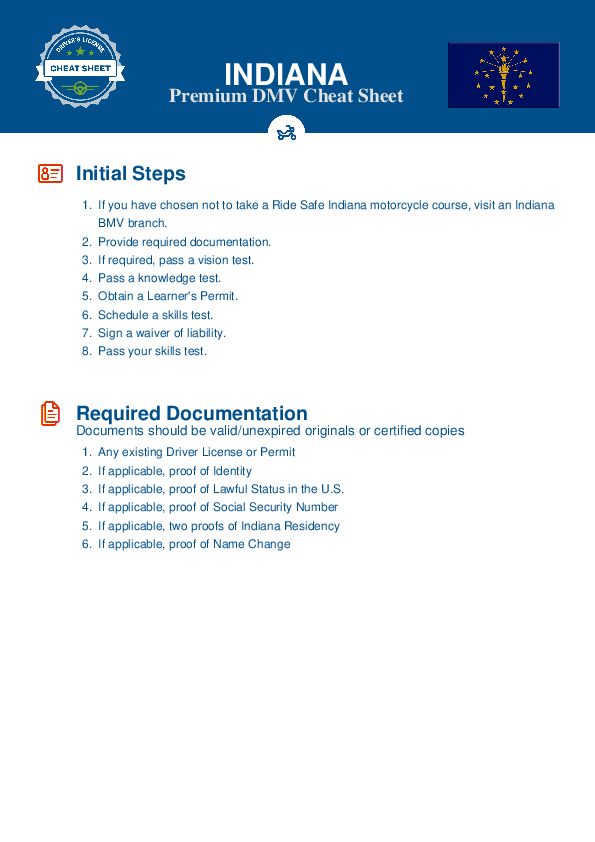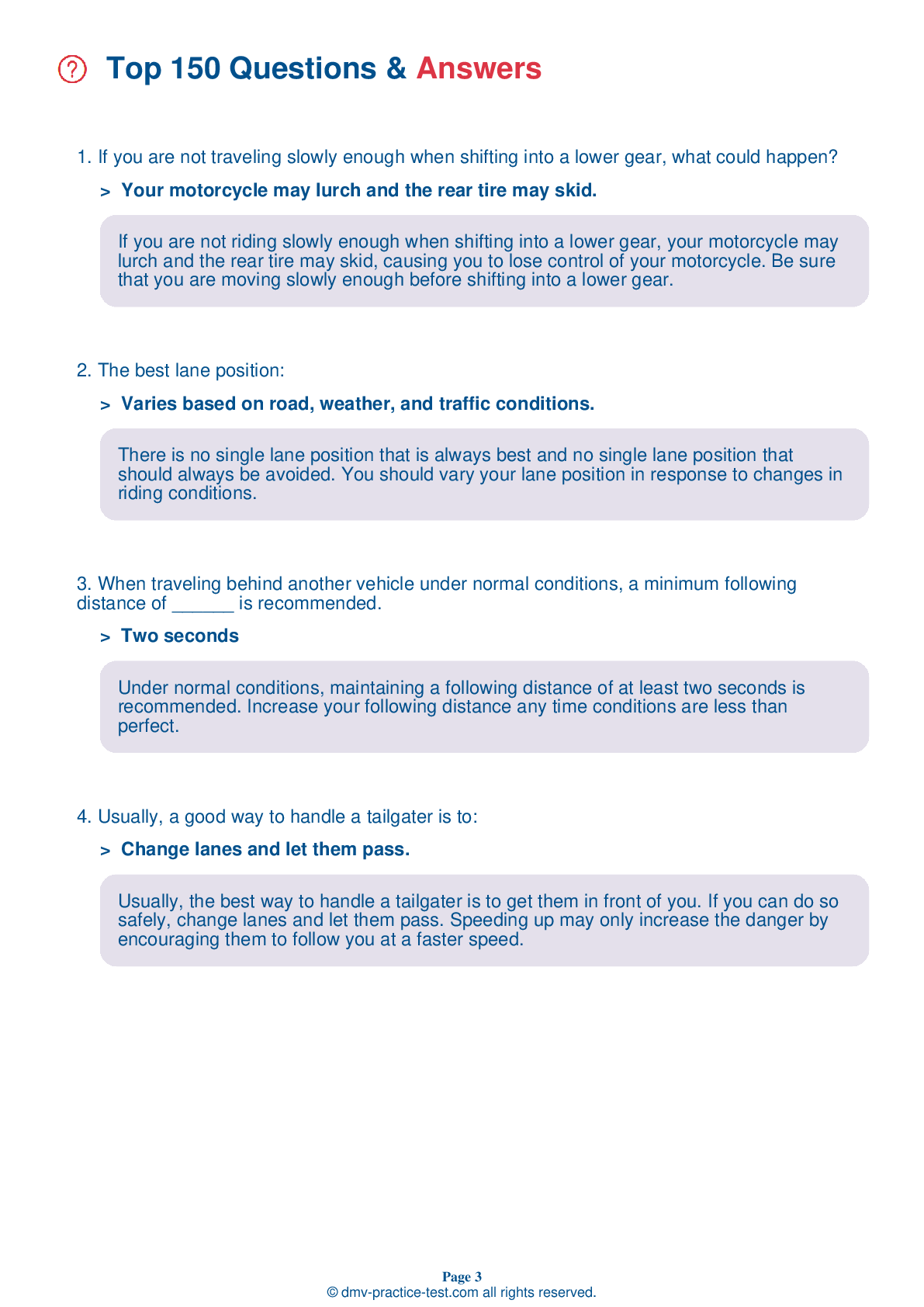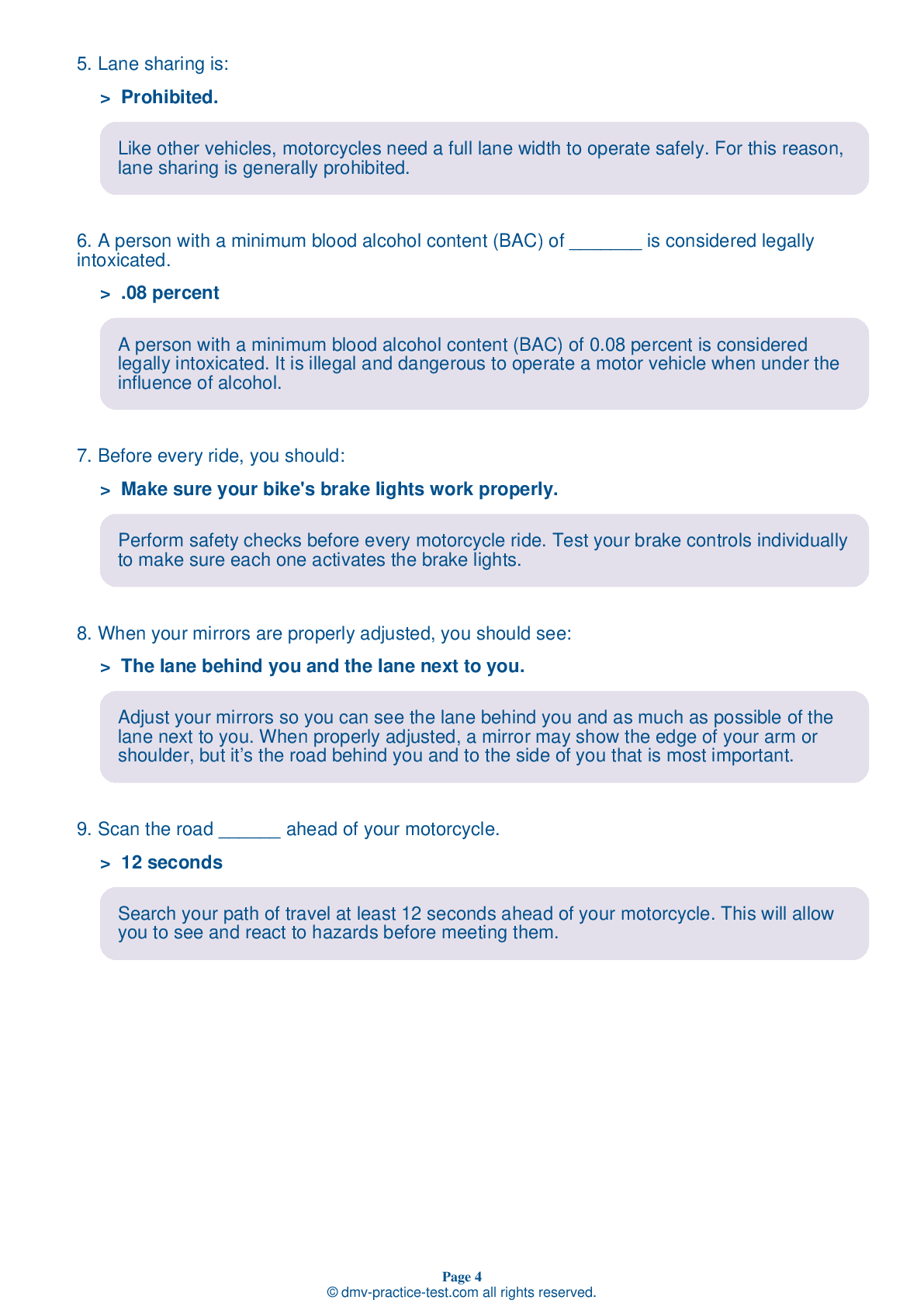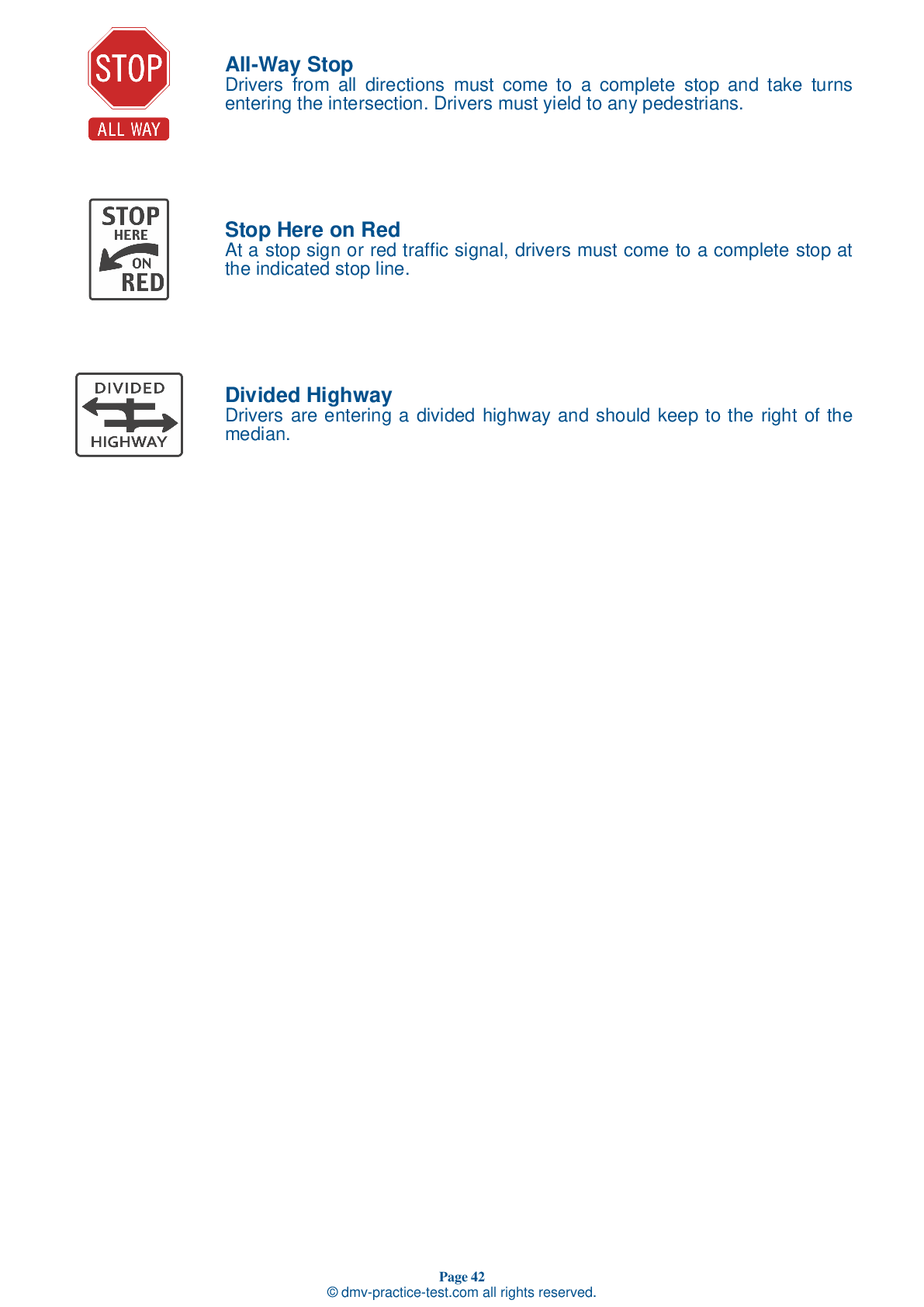DMV Permit Test #14
Motorcycle Test | License IN 2026 | FREE Online Practice! #14
Take this FREE motorcycle test (license in IN 2026) to check your knowledge of the road rules. To improve your results, download a motorcycle handbook online, study theory, and practice for free on our website. Still worried about how to get a motorcycle license in Indiana in 2026? Check our website for more sample tests, train as much as possible, and boost your grades!
25
21
16
1 . Switching to a lower gear is also known as:
Coasting.
Shifting to a lower gear causes an effect similar to using the brakes. For this reason, downshifting is also known as engine braking.
2 . A proper lane position should do all of the following, except:
Communicate your intentions to other road users.
A properly chosen lane position should provide a number of benefits, including an increased ability to see others and to be seen. It should help you avoid wind blasts, other drivers' blind spots, and surface hazards. Your lane position should discourage other drivers from trying to share your lane and provide you with an escape route, should a hazard arise.
3 . Riding under the influence of any medication which impairs your riding is permitted:
At all times.
Many prescription and non-prescription drugs can impair the safe operation of motor vehicles. You should never operate a motor vehicle on any roadway with any trace of a controlled drug, substance, or intoxicating compound in your blood.
4 . Your street-legal motorcycle should have all of the following, except:
A horn.
At minimum, a street-legal motorcycle must have a headlight, taillight, and brake light; front and rear brakes; turn signals; a horn; and two mirrors.
5 . When a lead rider is bending their left arm at the elbow, pointing upward, and swinging their arm toward their helmet, it means:
Slow down.
Hand signals are an important part of communication when riding in groups. When the lead rider's left arm is positioned for a right turn and swinging toward their helmet, it means the riders should pull off the road.
6 . When turning a three-wheeled motorcycle, there is a tendency for:
All wheels to leave the pavement.
During a turn, inertia causes the motorcycle's center of gravity to shift sideways and outward toward the tip-over line. The reduced weight over the opposite side wheel can cause it to lift slightly. The tendency of the rear inside wheel to lift when turning is greater with increased speed.
Need Motorcycle Insurance? No problem!
Compare the best rates in Indiana and find a personalized policy that meets your needs.
1. Are You Currently insured ?
2. Married ?
3. Do you own your Home?
4. Have you or a Family Member Honorably Served in U.S. Military ?
5. Your Name
6. Age
7. Zip code
Ranked by best match
2026 Indiana | Frequently Asked Questions
To acquire a motorcycle license in Indiana, you must first hold a valid Indiana driver's license. Then, you'll need to pass a written motorcycle knowledge exam and a motorcycle skills exam. Alternatively, you can complete a state-approved motorcycle safety course which often waives the skills test requirement. You must also pay the necessary fees to receive your motorcycle endorsement.
In Indiana, the minimum age to obtain a motorcycle driver's license is 16 years and 90 days. However, before getting a full endorsement, riders under the age of 18 must hold a valid motorcycle learner's permit for at least 30 days and must successfully complete a state-approved motorcycle safety course.
Yes, you do need a dedicated license for motorcycle riding in Indiana. This is known as a motorcycle endorsement and it is added to your regular driver's license. To obtain this endorsement, you must pass a written test and a riding skills test. Alternatively, completion of an approved motorcycle safety course can waive these testing requirements.
To apply for a motorcycle driver's license in Indiana, you'll need the following documents: proof of identity (like a birth certificate or passport), proof of Social Security number, proof of lawful status in the U.S., and two proofs of Indiana residency. If you're under 18, you'll also need a legal guardian's consent and proof of enrollment in school.
Yes, you will need to take a written exam to get a motorcycle license in Indiana. The exam covers topics such as traffic laws, road signs, and safe riding techniques. However, if you successfully complete an approved motorcycle rider education course, the written and skills tests may be waived.
The motorcycle written test in Indiana covers various subjects related to motorcycle safety and operation. Topics include traffic laws, road signs, safe riding techniques, handling dangerous situations, and motorcycle maintenance. The test also covers protective gear, passenger rules, and alcohol/drug effects on riding. Studying the Indiana Motorcycle Operator Manual is recommended to prepare for the test.
Yes, in Indiana, completing a state-approved motorcycle safety course can substitute for the written and skills tests required for a motorcycle endorsement. The course includes classroom instruction and hands-on training. Upon successful completion, you'll receive a waiver for the BMV tests. However, you still need to apply in-person at a BMV branch to add the endorsement to your license.
To enroll in a motorcycle training course in Indiana, first, find a state-approved course provider. Then, sign up either online or by phone. Courses usually require payment upfront. You'll need a valid driver's license or learner's permit. Some courses provide motorcycles and helmets, but check with the provider. Once enrolled, attend all sessions and successfully complete the course to receive certification.
No, you do not need to own a motorcycle to take the license test in Indiana. You can use a borrowed motorcycle, as long as it is street-legal, properly insured and registered. However, the motorcycle must be appropriate for your size and skill level. Remember to bring a helmet and eye protection for the test.
Yes, you can use a friend's motorcycle for your driver's license evaluation in Indiana, provided the motorcycle is street-legal, registered, insured, and you have permission to use it. It must also meet all safety requirements and be appropriate for your size and skill level. You'll also need a helmet and protective eyewear.
Yes, in Indiana, the motorcycle driving exam tests specific handling skills. These include left and right turns, swerving, quick stops, cone weaving, and U-turns. The test evaluates the rider's ability to control the motorcycle, make safe riding decisions, and apply Indiana's traffic laws. The skills test is designed to ensure motorcyclists can operate their vehicles safely on the road.
Yes, in Indiana, new motorcycle drivers under the age of 18 must first obtain a motorcycle learner's permit. This permit has restrictions such as no nighttime riding, no passengers, and no interstate riding. After 30 days of maintaining a learner's permit, they can apply for a motorcycle endorsement or license.
Yes, your Indiana driver's license with a motorcycle endorsement allows you to operate a motorcycle in other states. However, it's important to note that you must abide by the traffic laws of the state you are in, which may differ from those in Indiana. Always check local laws when traveling out of state.
In Indiana, state law requires all motorcycle riders under the age of 18 to wear a helmet and eye protection. However, riders aged 18 and over are not legally required to wear a helmet. Despite this, it's highly recommended for all riders to wear a helmet for their safety, as it greatly reduces the risk of head injuries.
Yes, Indiana offers two types of motorcycle licenses: a motorcycle-only license and a motorcycle endorsement. The motorcycle-only license allows you to only operate a motorcycle, while the motorcycle endorsement can be added to a valid Indiana driver's license, permitting you to operate both a motor vehicle and a motorcycle.
Yes, you can add supplementary endorsements to your motorcycle license in Indiana. These endorsements allow you to operate different types of motorcycles. However, each endorsement may require additional testing. It's recommended to check with the Indiana Bureau of Motor Vehicles for specific requirements related to the endorsement you want to add.
Yes, in Indiana, the motorcycle written test is available in several languages other than English. This is to accommodate a diverse range of applicants. However, it's advisable to contact your local BMV branch beforehand to confirm the availability of the test in your preferred language.
An effective strategy to prepare for the motorcycle license test in Indiana is to study the Motorcycle Operator Manual, which is available online or at any BMV branch. The manual covers all the information you need. Also, taking online practice tests can be beneficial as they familiarize you with the format and type of questions on the actual test. Remember to get enough rest before your test day.
Yes, the motorcycle written exam in Indiana can be taken in several languages other than English. The Bureau of Motor Vehicles (BMV) offers the exam in 14 different languages. However, it's recommended to contact your local BMV branch ahead of time to ensure your preferred language is available.
Yes, retaking is allowed if you don't pass the motorcycle written test in Indiana. After failing, you need to wait at least one day before retaking the test. However, if you fail the test three times, you must wait two months from the date of the last failed test before attempting again. It's advisable to study thoroughly to improve your chances of passing.



